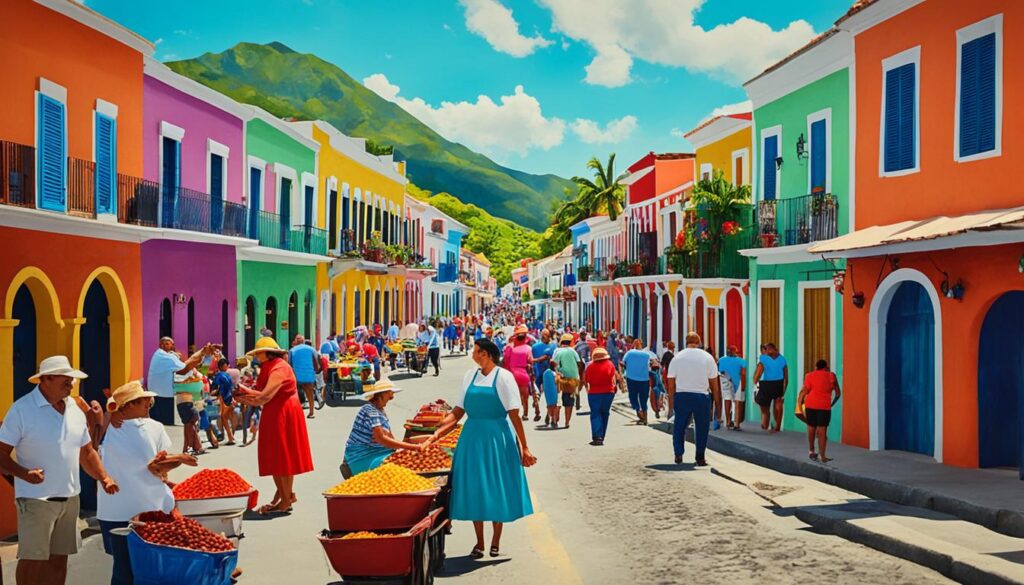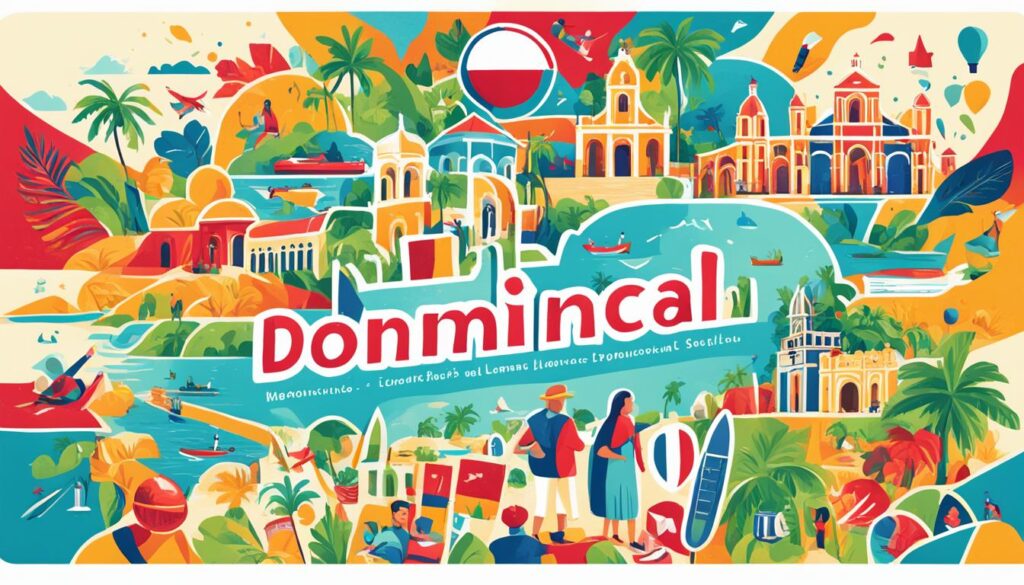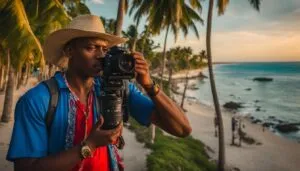Looking for professional wedding photographers in Punta Cana? Look no further! At JJ Studio Photo, we pride ourselves on being the top team of wedding photographers in the area. With over 15 years of experience, we specialize in capturing unforgettable moments on your special day.
Whether you’re planning a destination wedding, an engagement shoot, couple photo sessions, or family sessions, we have the expertise and creativity to make your photos truly exceptional. Our team has worked and lived in Punta Cana and all over the country, allowing us to capture the stunning beauty of the Dominican Republic in every shot.
Visit our website jjstudiophoto.com to view our portfolio and learn more about our services. We are dedicated to providing you with stunning wedding photography that will exceed your expectations.
Ready to book? Request a free appointment by calling us at âï¸ +1 849 387 9900.
Key Takeaways:
- We are the best team of wedding photographers in Punta Cana, with over 15 years of experience.
- We specialize in wedding photography, engagement shoots, couple photo sessions, and family sessions.
- Our team has extensive knowledge of Punta Cana and the Dominican Republic, ensuring captivating and breathtaking photos.
- Visit our website to view our portfolio and learn more about our services.
- Contact us at âï¸ +1 849 387 9900 to request a free appointment and book our services for your special day.
Official Language of the Dominican Republic
The official language of the Dominican Republic is Spanish, making it a Spanish-speaking country. Spanish is widely spoken by the majority of the population and is the primary language used in government, education, and business. The influence of Spanish colonization is evident in the various Dominican Spanish dialects and variations that exist within the country.
Proficiency in Spanish is essential for daily communication and integration into Dominican society. Whether you’re conducting business, exploring the vibrant local culture, or simply conversing with locals, having a strong grasp of the Spanish language will enhance your experience and interactions in the Dominican Republic.
«The official language of the Dominican Republic is Spanish, making it a Spanish-speaking country.»
To fully immerse yourself in the local culture and navigate through the vibrant streets of the Dominican Republic, it is recommended to learn some basic Spanish phrases and expressions. This will not only enable you to communicate effectively but also show respect for the country’s official language and its people.
Spanish Language in the Dominican Republic
The Spanish language spoken in the Dominican Republic has its own unique characteristics and regional variations. While the standard Spanish language is understood and widely spoken, you may encounter distinct accents, vocabulary, and idiomatic expressions that are specific to various parts of the country.
The Spanish language in the Dominican Republic is constantly evolving and influenced by cultural, historical, and social factors. From the fluid conversations in the bustling markets to the rhythmic lyrics of Dominican music, the Spanish language is deeply intertwined with the country’s rich cultural heritage.
Embracing the official language of the Dominican Republic will not only open doors to authentic experiences but also allow you to connect with the warm and welcoming local community. So, whether you’re planning a visit for leisure or business, take the opportunity to immerse yourself in the beauty of the Spanish language during your time in the Dominican Republic.

Visit our website jjstudiophoto.com to learn more about our services and book a free appointment to capture your unforgettable moments in the Dominican Republic. Don’t miss the chance to have stunning images that reflect the essence of this beautiful Spanish-speaking country.
Languages Spoken in the Dominican Republic
The Dominican Republic is a country known for its linguistic diversity. While Spanish is the main language spoken throughout the country, there are also various regional dialects and variations of Spanish that reflect the cultural diversity of the Dominican Republic.
Some of the common dialects spoken in different regions include:
- Cibaeño: This dialect is spoken in the Cibao region and is characterized by its distinct pronunciation and vocabulary.
- Santo Domingo Spanish: This dialect is spoken in the capital city of Santo Domingo and is influenced by African, European, and indigenous languages.
- Samaná English: This dialect is spoken in the Samaná Peninsula and is a mix of Spanish and English due to the influence of the local population and tourism industry.
These dialects may differ in terms of pronunciation, vocabulary, and grammar, highlighting the cultural diversity and regional influences in the Dominican Republic.
The following table provides a comparison of the main dialects spoken in the country:
| Dialect | Region | Characteristics |
|---|---|---|
| Cibaeño | Cibao region | Distinct pronunciation and vocabulary |
| Santo Domingo Spanish | Santo Domingo | Influenced by African, European, and indigenous languages |
| Samaná English | Samaná Peninsula | Mix of Spanish and English |
âLanguage is the roadmap of a culture. It tells you where its people come from and where they are going.â – Rita Mae Brown
These distinct dialects reflect the rich cultural heritage and regional influences in the Dominican Republic. They contribute to the vibrant linguistic landscape of the country and showcase the diverse identities and communities that exist within its borders.

Continue reading to learn more about the indigenous languages spoken in the Dominican Republic and the efforts being made to preserve linguistic diversity in the country.
Dominican Republic Culture and Language
The culture of the Dominican Republic is a rich tapestry woven from diverse influences, reflecting the country’s history and heritage. This unique blend of African, European, and indigenous traditions has shaped a distinct cultural identity that is celebrated and expressed through language.
Spanish, as the dominant language in the Dominican Republic, serves as the primary means of communication. It not only connects people but also embodies the country’s cultural essence. The Spanish language, with its various dialects, carries the stories, expressions, and idioms that encapsulate the Dominican way of life.
Language is the key that unlocks the doors to Dominican culture, allowing you to delve deeper into the heart and soul of its people.
In the lively conversations among Dominicans, you’ll encounter colorful local expressions and slang that add flavor and depth to their communication style. These linguistic nuances reflect the vibrancy, warmth, and hospitality that define Dominican culture.
To truly appreciate the richness of Dominican culture, immersing yourself in the language is essential. The Dominican Republic offers a myriad of cultural experiences, from traditional dances like merengue and bachata to mouthwatering cuisine like sancocho and mangu.
Dominican Culture at a Glance:
| Aspect | Characteristics |
|---|---|
| Music and Dance | Merengue, bachata, and salsa are popular genres, and dancing is an integral part of social gatherings. |
| Cuisine | Rich flavors influenced by African, Spanish, and indigenous ingredients, with staple dishes such as tostones, arroz con habichuelas, and lechón. |
| Sports | Baseball is a national passion, with many Dominican players excelling in Major League Baseball. |
| Festivities | Colorful celebrations such as Carnival and the Dominican Independence Day commemorate the country’s history and cultural diversity. |
| Art and Crafts | Handcrafted goods, including intricate pottery, ceramics, and vibrant paintings, showcase the talent and creativity of Dominican artists. |
Exploring these cultural facets will deepen your understanding and appreciation of the Dominican Republic and its people. Language acts as a bridge, connecting you with the rich tapestry of traditions and customs that make this Caribbean nation truly unique.
Embark on a journey of discovery and immerse yourself in the language, culture, and warmth of the Dominican Republic. Request a free appointment today to learn more about our services and start your adventure in this vibrant country.
Visit our website jjstudiophoto.com to learn more!
Indigenous Languages in the Dominican Republic
While Spanish is the dominant language in the Dominican Republic, there are also indigenous languages spoken by smaller communities within the country. The most prominent indigenous language is TaÃno, which was spoken by the indigenous TaÃno people before the arrival of the Spanish. Today, there are efforts to revive and preserve the TaÃno language, as it represents an important part of the Dominican Republic’s indigenous heritage. Other indigenous languages spoken in the country include Ciguayo and Macorix. These languages are primarily spoken in specific regions with indigenous communities.
Language Diversity in the Dominican Republic
The Dominican Republic is a country renowned for its linguistic diversity. While Spanish is the predominant language spoken by the majority of the population, there are also communities within the country that communicate in languages other than Spanish. This linguistic variety is a reflection of the historical, cultural, and geographical connections the Dominican Republic has with various communities and nations.
One notable language spoken in the country is Haitian Creole, which is primarily used by the Haitian minority population, especially in border regions. As neighboring countries, the Dominican Republic and Haiti share a close proximity, leading to the influence and presence of Haitian Creole within the country.
Furthermore, English is commonly spoken in tourist areas and by individuals working in the tourism industry. With the Dominican Republic being a popular tourist destination, proficiency in English allows for effective communication with international visitors. The ability to comfortably converse in English enhances the overall tourism experience for visitors and facilitates smooth interactions between tourists and locals.
The Dominican Republic also has a rich linguistic heritage of indigenous languages. While these languages are spoken by smaller communities, they hold significant cultural value and are vital in preserving the country’s indigenous heritage. These indigenous languages include TaÃno, Ciguayo, and Macorix, spoken in specific regions with indigenous communities.
«Language diversity in the Dominican Republic reflects the country’s historical, cultural, and geographical connections with various communities and nations.»
Embracing language diversity in the Dominican Republic promotes inclusivity, cultural exchange, and understanding among different groups and communities. It creates an enriching environment where individuals from various backgrounds can share their unique languages and traditions, fostering unity and appreciation for the country’s multicultural fabric.
| Languages Spoken | Key Communities/Niches |
|---|---|
| Haitian Creole | Haitian minority population, primarily in border regions |
| English | Tourist areas, tourism industry professionals |
| Indigenous languages (TaÃno, Ciguayo, Macorix) | Indigenous communities in specific regions |
Language Education in the Dominican Republic
In the Dominican Republic, language education plays a vital role in shaping the linguistic skills and cultural understanding of students. With Spanish being the official language, schools prioritize the development of proficiency in reading, writing, and speaking Spanish. Alongside Spanish, English is taught as a second language in many schools, especially in urban areas or schools that cater to international students.
Bilingual education programs are also becoming increasingly common, aiming to provide students with fluency in both Spanish and English. Such programs recognize the global importance of English and strive to equip students with the necessary language skills to thrive in today’s interconnected world.
The Benefits of Bilingual Education
By offering bilingual education programs, the Dominican Republic seeks to empower students with the ability to communicate effectively in multiple languages. This opens doors to a wider range of educational and career opportunities. Bilingual individuals have a competitive edge in the job market, as they can engage with international companies and collaborate with colleagues from different backgrounds.
Moreover, bilingual education promotes cultural exchange and fosters an appreciation for diverse perspectives. Through learning a second language, students gain insights into different cultures, traditions, and ways of thinking. Bilingualism enhances cognitive abilities, such as problem-solving and critical thinking, while also nurturing empathy and intercultural competence.
Language Education Initiatives
To promote language education and increase language proficiency among students, the Dominican Republic’s government and educational institutions have implemented various initiatives. These initiatives include:
- Enhancing language curriculum: Schools continually update their curriculum to incorporate best practices in language teaching and learning.
- Teacher training programs: Educators receive professional development opportunities to enhance their language teaching skills and methodologies.
- Language exchange programs: Students have the chance to participate in language exchange programs, where they can interact with native speakers of different languages, further developing their language skills and cultural understanding.
- Technology integration: Educational institutions utilize technology to enhance language education, providing interactive learning platforms and online resources.
By prioritizing language education and implementing these initiatives, the Dominican Republic aims to equip students with the critical language skills necessary to thrive in an increasingly interconnected world.
| Benefits of Language Education in the Dominican Republic | Initiatives |
|---|---|
| 1. Enhanced career opportunities | 1. Enhancing language curriculum |
| 2. Cultural exchange and intercultural competence | 2. Teacher training programs |
| 3. Cognitive benefits, such as problem-solving and critical thinking | 3. Language exchange programs |
| 4. Empathy and understanding of diverse perspectives | 4. Technology integration |
Language and Tourism in the Dominican Republic
Language is a crucial element in the vibrant tourism industry of the Dominican Republic. With countless tourists flocking to the country each year, the ability to communicate in languages other than Spanish provides a significant advantage for professionals in the tourism sector. English, being the most commonly spoken language among tourism professionals, facilitates effective communication with international visitors, enhancing their overall experience. Mastering language skills, particularly in English, can open doors to a multitude of employment opportunities and greatly contribute to customer satisfaction in the dynamic and ever-growing tourism industry.
At JJ Studio, we understand the importance of language proficiency for tourism professionals. Our team of highly skilled photographers and videographers is fluent in English and Spanish, ensuring seamless communication with clients from all over the world. We strive to capture the essence of your unforgettable experiences in the Dominican Republic through exceptional visual storytelling.
«The ability to communicate effectively in multiple languages allows tourism professionals to connect with visitors on a deeper level, making their stay in the Dominican Republic truly memorable.»
Whether you’re planning a destination wedding, a romantic honeymoon, a family vacation, or any other special occasion, our team at JJ Studio is dedicated to providing you with exceptional service. With our expertise in photography and videography, we aim to capture your precious moments in the Dominican Republic while ensuring your comfort and satisfaction throughout the process.
Visit our website jjstudiophoto.com to explore our portfolio and discover how we can turn your treasured memories into timeless works of art.
| Benefits for Tourism Professionals | Enhanced Employment Opportunities | Improved Customer Satisfaction |
|---|---|---|
| â Effective communication with international visitors | â Increased demand for language-proficient professionals | â Understanding and meeting the needs of diverse clients |
| â Opportunity to work in prestigious international establishments | â Ability to cater to a wider range of clientele | â Positive reviews and recommendations from satisfied customers |
| â Networking with professionals from around the globe | â Higher earning potential and career growth | â Building strong relationships with repeat clients |
Importance of Language in Daily Life
In the Dominican Republic, language holds immense significance in daily life. It serves as the primary means of communication in various spheres, including social interactions, work, education, and accessing public services. Proficiency in language empowers individuals to express themselves effectively, connect with others, and navigate through different aspects of life in the country.
The ability to communicate in the dominant language, Spanish, is crucial for integration and active participation in Dominican society. It opens doors to opportunities, fosters relationships, and enables individuals to fully engage in the cultural fabric of the country. Fluency in Spanish allows you to interact with fellow Dominicans, understand local customs and traditions, and form meaningful connections.
Breaking Down Language Barriers
Language serves as a bridge between different cultures and communities. It acts as a unifying force, fostering understanding and unity among diverse groups. In the Dominican Republic, where cultural diversity abounds, being able to communicate effectively in Spanish enables you to engage with people from various backgrounds and establish meaningful connections.
Whether you are interacting with locals, exploring the vibrant markets, or immersing yourself in the rich cultural heritage of the country, language plays a crucial role in bridging gaps and facilitating meaningful exchanges. It allows you to connect with others on a deeper level, breaking down barriers and bringing people together.
«Language is the road map of a culture. It tells you where its people come from and where they are going.» – Rita Mae Brown
The Role of Language in Personal and Professional Growth
Proficiency in the language spoken in the Dominican Republic is not only essential for day-to-day life but also crucial for personal and professional growth. The ability to communicate effectively in Spanish opens up a world of opportunities, both in the workplace and in personal relationships.
From job interviews and business meetings to navigating professional environments, language skills are highly valued and can significantly enhance your career prospects. Bilingualism, particularly in Spanish and English, is an asset in today’s globalized world, providing you with a competitive edge in various industries, including tourism, international trade, and customer service.
Furthermore, language proficiency enables you to access educational resources, broaden your knowledge, and expand your horizons. It allows you to engage with Dominican literature, history, and culture, enabling a deeper understanding and appreciation of the country and its people.
Unlock the Power of Language in the Dominican Republic
Language is not merely a tool of communication; it is a gateway to cultural exploration, personal growth, and meaningful connections. In the Dominican Republic, Spanish is the key that unlocks the country’s vibrant tapestry of culture, history, and traditions.
Whether you are a visitor or a resident, embracing the importance of language in daily life enriches your experiences and facilitates meaningful relationships. Take the opportunity to learn and appreciate the language spoken in the Dominican Republic, and you will discover a world of possibilities.
Visit our website jjstudiophoto.com to learn more about Dominican culture, find language learning resources, and request a free appointment to capture the beauty of the Dominican Republic through the lens of our professional photographers.
Cultural Influence on Language
The culture of the Dominican Republic exerts a significant influence on the language spoken in the country. It is a fusion of African, European, and indigenous cultures that has shaped a unique linguistic landscape. Dominican Spanish, with its distinct vocabulary, pronunciation, and expressions, reflects the rich cultural diversity of the nation.
The cultural context plays a vital role in shaping language use, with idioms, slang, and colloquialisms becoming integral parts of everyday communication. These linguistic elements add depth and flavor to conversations, providing a glimpse into the vibrant Dominican culture.
«Language is a reflection of culture, and in the Dominican Republic, it truly reflects the vibrant and diverse tapestry of our society,» says Carlos Rodriguez, a linguistics professor at the University of Santo Domingo.
Traditional cultural practices and customs also influence the way language is used. For example, the use of respectful pronouns and greetings is deeply ingrained in Dominican culture, emphasizing politeness and a strong sense of community. Additionally, the influence of Afro-Dominican traditions can be seen in the rhythmic and expressive nature of speech, with elements of music and dance intertwining with language.
The cultural influence on language is reflected in various spheres of Dominican life, including literature, music, and art. Renowned authors like Julia Alvarez and Junot Diaz incorporate Dominican cultural references and linguistic nuances into their works, contributing to the preservation and celebration of Dominican identity.
Dominican Idioms:
- «Poner el dedo en la llaga» – Literally meaning «to put your finger on the wound,» this idiom refers to highlighting or exposing a sensitive or uncomfortable topic.
- «Estar en las nubes» – Translated as «to be in the clouds,» this expression means someone is daydreaming or not paying attention.
- «Dar en el clavo» – Meaning «to hit the nail on the head,» this idiom denotes someone who has made an accurate or correct statement.
The cultural influence on language in the Dominican Republic is a testament to the country’s rich heritage and diversity. It serves as a powerful tool for preserving traditions, expressing identity, and fostering connection among its people.
Language Preservation Efforts
In the Dominican Republic, there are dedicated efforts to preserve and promote indigenous languages, such as TaÃno. These initiatives aim to document, revive, and teach these languages to ensure their survival and transmission to future generations. Recognizing the importance of linguistic diversity and the cultural heritage associated with indigenous languages, organizations and community leaders are working tirelessly to preserve these invaluable linguistic treasures.
Language preservation is seen as a way to honor the history, traditions, and contributions of indigenous communities in the Dominican Republic. By protecting and revitalizing these languages, the country can celebrate and showcase the unique cultural and linguistic tapestry that has shaped its identity over centuries.
«Preserving indigenous languages is not just about words, but about safeguarding cultural knowledge, ancestral wisdom, and a sense of belonging.»
Through language preservation initiatives, the Dominican Republic is taking significant steps to ensure that the voices and expressions of its indigenous communities continue to thrive. These efforts go beyond academic research and include community language programs, storytelling, and cultural events that celebrate the rich linguistic heritage of the country.
Indigenous Languages in the Dominican Republic
| Indigenous Language | Native Speakers | Regions |
|---|---|---|
| TaÃno | Reviving and limited speakers | Throughout the country |
| Ciguayo | Very few speakers | In specific regions |
| Macorix | Only a few speakers | In certain regions |
These language preservation endeavors in the Dominican Republic serve as a testament to the country’s commitment to safeguarding the unique linguistic heritage and cultural legacy of its indigenous communities. By valuing and supporting indigenous languages, the Dominican Republic not only preserves the past but also fosters inclusivity, cultural exchange, and mutual understanding in the present and future.
To learn more about the language preservation efforts and the cultural richness of the Dominican Republic, visit our website at jjstudiophoto.com.
Language as a Cultural Connector
Language serves as a cultural connector in the Dominican Republic, bridging different communities, generations, and cultural backgrounds. It enables you to express your unique identity, connect with your heritage, and participate in cultural practices. Through language, traditions, customs, and stories are shared and passed down, preserving the intangible cultural heritage of the Dominican Republic.
In the Dominican Republic, language is more than just a means of communication. It is a reflection of the vibrant and diverse cultural tapestry that exists within the country. Whether you are speaking Spanish, the official language, or one of the indigenous languages, language acts as a unifying force, promoting understanding, empathy, and appreciation for the rich cultures that coexist.
«Language is the key that unlocks the door to culture. It allows us to understand and appreciate the nuances of a society, and with that understanding comes a deeper connection and respect for one another.»
Language connects you to your roots and helps you navigate the intricacies of cultural norms and traditions. It allows you to engage in conversations about history, art, music, and folklore, fostering a sense of belonging and pride in your cultural heritage. Whether you are attending a traditional dance performance, participating in a religious ceremony, or simply interacting with locals in the marketplace, language enables you to fully immerse yourself in the richness of Dominican culture.
Furthermore, language is a vehicle for intergenerational exchange, allowing knowledge and wisdom to be passed on from one generation to the next. Through storytelling, proverbs, and folktales, older generations share their experiences, values, and life lessons with younger generations. Language becomes the conduit through which cultural traditions are preserved and community bonds are strengthened.
Cultural celebrations and festivals also rely on language to unite people in shared experiences. Whether it’s the colorful Carnaval celebrations, traditional religious processions, or music and dance festivals, language is at the heart of these cultural events. From the chants and songs to the lively conversations and expressions of joy, language brings people together, creating a sense of unity and celebrating the diversity that exists within the Dominican Republic.
The role of language as a cultural connector in the Dominican Republic cannot be overstated. It shapes our identities, facilitates understanding, and serves as a gateway to the rich tapestry of cultural traditions that define the country. By embracing and valuing the languages spoken in the Dominican Republic, we foster appreciation, respect, and a deeper connection to the vibrant and diverse communities that make up this beautiful nation.
| Language | Role |
|---|---|
| Spanish | The official language of the Dominican Republic, used in government, education, and business. |
| Indigenous Languages | Preserving the intangible cultural heritage of the Dominican Republic. |
| Haitian Creole | Facilitating communication with the Haitian minority population. |
| English | Important for the tourism industry and international communication. |
Conclusion
The Dominican Republic is a linguistically diverse country with Spanish as the official language. However, it also boasts a rich tapestry of dialects spoken throughout the various regions. In addition to Spanish, indigenous languages like TaÃno hold cultural and historical significance, with ongoing efforts to preserve and promote them.
Language plays a pivotal role in daily life, education, and tourism in the Dominican Republic. Being able to communicate effectively in Spanish is essential for integration into Dominican society, while English proficiency is particularly advantageous in the tourism industry. Language connects people, fosters unity, and allows for the expression of cultural identity.
To truly appreciate the vibrant cultural landscape of the Dominican Republic, understanding the language diversity is crucial. It provides a deeper understanding and appreciation for the country’s rich heritage. To learn more about the Dominican Republic’s language and culture, visit our website at jjstudiophoto.com and request a free appointment by calling âï¸+1 849 387 9900.
FAQ
What languages are spoken in the Dominican Republic?
The official language of the Dominican Republic is Spanish. However, there are also various dialects and variations of Spanish spoken in different regions of the country. Additionally, indigenous languages such as TaÃno, Ciguayo, and Macorix are spoken by smaller communities.
Is English spoken in the Dominican Republic?
Yes, English is widely spoken in tourist areas and by those working in the tourism industry.
What is the official language of the Dominican Republic?
The official language of the Dominican Republic is Spanish.
Are there indigenous languages spoken in the Dominican Republic?
Yes, there are indigenous languages spoken by smaller communities in the Dominican Republic, including TaÃno, Ciguayo, and Macorix.
How important is language in the Dominican Republic?
Language plays a crucial role in daily life, education, work, and accessing public services in the Dominican Republic. It is essential for social interactions, cultural expression, and integration into society.
How is language influenced by Dominican culture?
The Dominican Republic’s cultural diversity and history have greatly influenced the language spoken in the country. Dominican Spanish dialects and variations reflect the fusion of African, European, and indigenous cultures, resulting in a unique linguistic landscape.
Are there language education programs in the Dominican Republic?
Yes, Spanish is taught as the primary language in schools, and English is taught as a second language in many schools, especially in urban areas. Bilingual education programs are also becoming more common.
How does language impact the tourism industry in the Dominican Republic?
Language skills, particularly in English, are advantageous for those working in the tourism industry as they enable effective communication with international visitors. English is the most commonly spoken language by tourism professionals.
Why is language preservation important in the Dominican Republic?
Efforts are being made to preserve and promote indigenous languages in the Dominican Republic to honor the country’s cultural heritage and the contributions of indigenous communities.
How does language serve as a cultural connector in the Dominican Republic?
Language is a means to express cultural identity, share traditions and stories, and foster understanding and unity among different communities and generations in the Dominican Republic.







